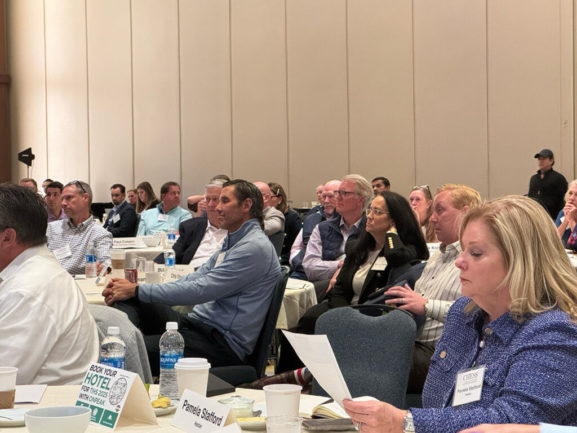Synthetic Brush Filament Q&A: Accelerated Growth
By Bob Lawrence
The global synthetic fiber market in which the synthetic brush filament industry is a small but growing segment is projected to increase by a Compound Annual Growth Rate (CAGR) of 6.9% during the next five years, according to a Facts and Factors market research study. The India-based firm says the projected value of the market by 2028 will be $102 billion USD, up from an initial value of $63.2 billion two years ago. These figures reflect the continued ubiquity of synthetic production in a multitude of global manufacturing sectors, including the brush industry in which non-natural filaments have experienced exponential growth. This is due, of course, to innovational research and development resulting in synthetic fiber mimicking natural fiber, and in some applications, being superior to it. Even so, this doesn’t signal the end of natural fibers in brush manufacturing as it is still the preference for specific applications. That being said, like the overall brush fiber market, the production of synthetic brush filaments, has suffered upheavals due to unforeseen events such as the COVID-19 pandemic, the resulting economic impact and now a war in Ukraine. To catch up on the overall impact, Brushware asked three major synthetic filament producers to provide input on the status of their industry today.

As a filament producer, what are the major challenges your company has to contend with?
Andrew McIlroy, Perlon’s sales and marketing director: Dating back to early 2021 through 2022, there were multiple increases in price applied by raw material suppliers, force majeure declarations for both base products and polymer, shortages of available product and much longer lead times than before. Thankfully this situation now seems to be behind us, with availability more or less back to normal and prices improving.
PMM General Manager Enrique Mejia: Inflation, raw materials availability, labor shortages.
Jon Monahan, President, Monahan Filaments: Labor and raw materials.
In the past two years, have there been any impediments to your acquiring petrochemicals to produce your product?
Andrew McIlroy: Yes very much so. Despite long-term planning and forecasting, we were often left short on the volumes we required to maintain normal production levels – we often had to prioritize customer requirements based on the availability of resin.
Jon Monahan: Yes. Our suppliers have dealt with the high cost of inputs (oil/chemicals), transportation and energy.
Enrique Mejia: Several shortages and force majeure announcements during the pandemic complicated the polymers sourcing. In addition, logistics, sea freight costs and container availability were a constant headache.
What country or countries supply the petrochemicals for your production?
Jon Monahan: US, Canada, Europe, Asia.
Andrew McIlroy: As a company with production sites on three continents we have a global supply chain. Typically, we try to source resin from companies located in the same region as our respective plants.
Enrique Mejia: We import engineering polymers mostly from the USA and Europe. A smaller volume from Asia.
Have there been any supply chain issues connected to the availability of petrochemicals for your production, and if so why?
Enrique Mejia: Force majeure announcements connected with weather events, plant accidents and major maintenance problems. I think, there were too many managers and supervisors working from home in the polymers industry production facilities and this lack of supervision originated mistakes everywhere.
Jon Monahan: Yes, ocean freight costs, energy costs and disruption due to global issues.
Andrew McIlroy: Starting in early 2021 and continuing throughout 2022 the availability of all polymer types has varied — from overnight force majeure declarations and an immediate cessation of supply to vastly reduced availability. We have heard every excuse going for this — too many to mention here.
And that has likely impacted costs?
Andrew McIlroy: Costs for every polymer have increased, some more than others. During COVID in 2020 and 2021, capacity was reduced worldwide, leading to severe shortages of everything, which led to major issues when demand increased in early 2021. High demand and low supply were, without doubt, the main reason for price increases — coupled with increased energy prices to manufacture said polymers.
Enrique Mejia: Prices went up as never before. For commodity plastic resins there have been some reductions but, still there is a lot of market uncertainty.
Jon Monahan: Overall demand is high and supply constrained — sanctions on Russia re-routing supply and contracts, US restrictions on domestic production, OPEC lowering production and other macro factors impacting supply and demand.

Where do you see costs going for the rest of the year and on into the next year?
Jon Monahan: Up to flat. It probably won’t go down unless a global recession looms. Inflationary pressures will probably offset any weakening in demand.
Enrique Mejia: We do not anticipate substantial cost reductions. The whole petrochemical and polymer production industry is rearranging. Several major company acquisitions are going on. I think this consolidation will keep prices high.
Andrew McIlroy: In Asia and Europe, prices have receded since the start of 2023 — all because demand is lower and availability is generally good. Future pricing will depend heavily on the global economic situation. If things improve generally, prices may rise again slightly. At some point, the low point will have been reached, and this will lead suppliers to limit availability in an attempt to drive prices up. Personally and hopefully, I would not expect to see any further increases
this year.
Have there been other increases in production costs during the past two years?
Enrique Mejia: Everything is up: interest rates, additives, colorants, packaging materials, labor and energy.
Andrew McIlroy: Labor costs due to a tight labor market, the price of gas and electricity, packaging costs and freight costs.
Jon Monahan: Labor, predominantly. Lack of qualified individuals and quantity of applicants.
What impact or ramifications has any of the above had on your customers?
Andrew McIlroy: Everyone has had to raise their prices to pass the additional cost down the supply chain. Due to the frequency and number of increases for polymer, this has led to severe uncertainty and the need to recost almost everything — a highly unusual situation. Product shortage also caused an element of ‘panic buying’, which extenuated the problem, increasing stocks and lead times.
Jon Monahan: Our customers are experiencing the same strains as us, as our inputs are not much different.
Enrique Mejia: Price adjustments in our products have been, unfortunately, a must.
Are there any problems in meeting your customers’ needs?
Enrique Mejia: No problems, because we have been very cautious with inventories and with alternative raw
material sources.
Andrew McIlroy: There were problems, but currently our lead times are more or less back to normal. Demand has fallen and people are partially still working through pre-ordered inventory from last year.
Jon Monahan: No current issues as lead times have fallen along with demand, but this is a seasonal phenomenon.
For brush making, how would you approximate the market share of synthetic filaments vs natural fibers?
Andrew McIlroy: This depends entirely on the type of brush and end application. For technical brushes, the percentage of synthetic filaments versus natural fiber is very high, due to the fact that natural fiber and animal hair cannot meet the quality standard required by most technical brushes. For various reasons, the overall percentage of natural fiber continues to decline, but there will always be a market for this for certain applications. This will continue to develop in favor of synthetic due to better availability, more stable pricing generally, unaffected by exchange rate variations, cleaner and easier processing, and consistency of quality.
Enrique Mejia: We are not in the natural fibers market. Our guess is that the synthetics proportion keeps growing to more than 80% of the market.
Jon Monahan: 80/20 is an estimate.
Can you comment on why synthetic filaments have increasingly become the predominant choice for brush manufacturers?
Jon Monahan: They are normally the right choice given the combination of price, manufacturability and performance. However, natural fibers perform better in certain niches and won’t disappear.
Andrew McIlroy: Again, this is application-specific, but synthetic filaments in their different forms can be far better tailored to an application. With natural hair or fiber, you get what nature provides.
Enrique Mejia: Natural fibers require a lot of labor and there is a limited availability. Tampico fiber is really appreciated by certain markets but, I think, that is an isolated case.
What are the advantages of synthetic filaments?
Andrew McIlroy: Wide polymer range offering different technical properties which can be tailored to any application. Can be ordered in a specific diameter and length. Functional additives to improve performance. Food approved (FDA). Tailored packaging configurations to suit all brush machinery types. Repeatable quality each time.
Enrique Mejia: Consistent properties and dimensions. No problems with toxicity and cleaning requirements. Available in a wide range of materials, colors, shapes, etc.
Jon Monahan: Uniformity, bend recovery, abrasion resistance and useful life. The latter also being a potential drawback when considering environmental concerns.

What are the primary brush segments using your filaments?
Enrique Mejia: Toothbrushes, cosmetic brushes and all types of industrial brushes.
Jon Monahan: Our fiber is used in most categories of brushes — staple set, strip, fused, epoxy, etc.
Andrew McIlroy: Our main focus is the technical/industrial brush market — for strip brushes, tufted brushes, roller brushes and twisted-in-wire brushes — used in a multitude of end applications.
Do you have any synthetic filament innovations for brush making in development that you wish to disclose?
Andrew McIlroy: We have new sustainable options made from bio-based polymers in our range — we fully expect the demand for these products to grow significantly in the future.
Enrique Mejia: We have several projects for major multinational customers that we cannot disclose.
Jon Monahan: We have focused on fibers that will perform at elevated temperatures at a lower cost than current incumbent fibers. Sustainable materials are another focus area. There is now market pressure to produce these materials more economically and research into improving properties.
Beyond providing synthetic filaments for the brush industry are there other applications where your filaments are used?
Enrique Mejia: Music strings. 3D printing filaments. Jewelry.
Jon Monahan: There are non-brush applications where our fiber is used as a filler or reinforcement.
Andrew McIlroy: The other main part of our business is in the field of technical textiles — spooled monofilament which is processed into technical fabrics generally — and used in the paper industry, filtration, automotive, agriculture as well as products for consumer applications such as fishing line and tennis racket string.
More Information
Monahan Filaments — http://www.monahanfilaments.com/
Perlon / Hahl — https://www.perlon.com/en/
PMM: Proveedora Mexicana de Monofilamentos, S.A. de C.V. — http://www.pmmbrightline.com/


